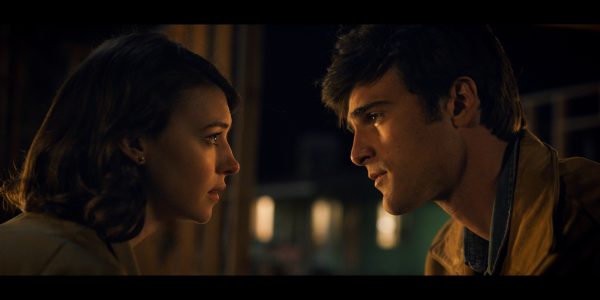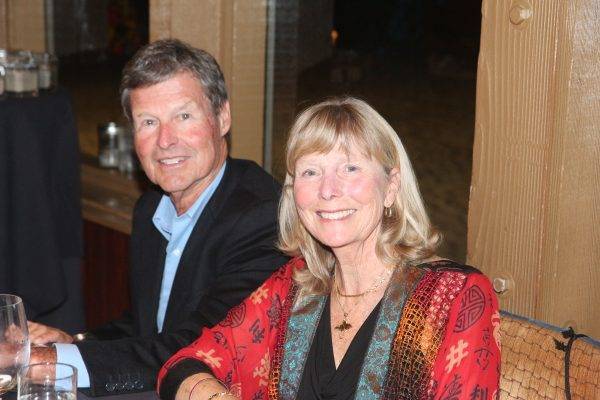
The first surprise, after one has sat down in the theater, is to look up and realize that most of the auditorium has been draped in black, as if in mourning.
What the audience learns soon enough is that the characters in “Follies” have gathered for one last hurrah on the stage of the Weismann Theatre. The year is 1971. This is their first and last reunion since the theater closed 30 years before. Since then it has had a variety of uses (think of our own Bijou in Hermosa – an art gallery and soon a bank), but now it’s to be leveled for a parking lot.
The somber black cloth and dim lighting provides an unsettling touch – and imagine if the conceit could have been extended, shrouding the entire Ahmanson with scaffolding and tarps with chain-link fences telling us that “Follies” is the last show before the wrecking crew steps in.
“Follies” is that true rarity, a thinking person’s musical, and a masterful collaboration between composer and lyricist Stephen Sondheim and book writer James Goldman. One doesn’t see it around much, because it needs to be done just right and that involves something no one has very much of these days – money. However, its merits didn’t go unnoticed after it opened, and it walked away with seven Tony Awards. This revival, originating from the John F. Kennedy Center for the Performing Arts, is directed by Eric Schaeffer, with music direction by James Moore and choreography by Warren Carlyle.
Just as the title can mean many things – from foolishness to theatrical revues – as in the Folies Bergère or the Ziegfeld Follies – “Follies” resonates on many levels. Embodied in it are the ghostly echoes of the heyday of musical theater between the two World Wars (reverberations of “The Drowsy Chaperone,” “Minsky’s,” “42nd Street,” etc.) as well as the ghostly echoes of our younger selves. It’s not just an old building that is coming down, it’s the demolition of all the memories contained within.
It also becomes a parade of “what if’s.” We meet several of the former leading ladies – Carol Neblett as Heidi Schiller, Mary Beth Peil as Solange LaFitte, Terri White as Stella Deems, Jane Houdyshell as Hattie Walker, and Elaine Paige as Carlotta Campion – actresses not always so familiar to us neophytes but names to reckon with for anyone serious about musical theater.
For the resonance between past and present to be most effective, we need to be mindful of the one while contemplating the other. Throughout the show, and mostly in the half-light of the background, elegantly attired showgirls slowly move dreamlike through the shadows. They are, perhaps, floating memories or even the former selves of the many actors and dancers we meet.
The narrative itself focuses on two married couples, Ben and Phyllis (Ron Raines, Jan Maxwell), and Sally and Buddy (Victoria Clark, Danny Burstein). Phyllis and Sally were Weismann Follies showgirls. Sally had been in love with Ben, they’d had a fling, but in the end Ben married Phyllis and Sally eventually settled for Danny. Although Danny idolizes Sally, we can see that Sally has never forgotten Ben – and so this reunion brings more than just people together; it brings back their long-suppressed or simmering emotions.
What follows is the kind of lyrical but intense drama we might expect from a play by Arthur Miller or Tennessee Williams. However, if we’re familiar with Sondheim’s “Company” (his preceding work) we realize quickly that we’re in the hands of an accomplished talent.

Ben’s “The Road You Didn’t Take” sums up the notion, spread evenly among the principals, that life can be long enough to contain many regrets. Sally’s “In Buddy’s Eyes,” Buddy’s “The Right Girl,” and Phyllis’s “Could I Leave You?” are the kind of mature, poignant songs that very few composers can effectively create, and each of them here adds another complex layer to this very human drama.
During the second act our characters seem to tumble more literally into their past, with an extended “Loveland” sequence that brings the Weismann Follies to life and in living color. The costumes (Gregg Barnes), the scenic design (Derek McLane), the lighting (Natasha Katz) – it’s all just gorgeous. However, as Chad and Jeremy once sang, “but that was yesterday, and yesterday’s gone.”
This may be considered a pessimistic show – true love is just for fairy tales and other musicals – but it is a sweet poison. A great deal of collaborative genius went into it (younger version of the lead characters onstage at the same time, for instance, yet receded, and in muted colors). As the title of Ted Chapin’s account of how this musical was created boldly states, Everything Was Possible. This is a show, and a production, that reveals what an achievement “Follies” was in 1971 – and again in 2012.
Follies is onstage at the Ahmanson Theatre 135 N. Grand Ave., downtown Los Angeles in the Music Center. Performances, Tuesday through Friday at 8 p.m., Saturday at 2 and 8 p.m., plus Sunday at 1 and 6:30 p.m. Note: Added 2 p.m. shows on Thursdays, May 31 and June 7; added show on Monday, June 4. No 6:30 p.m. show on Sunday, June 3. Closes June 9. Tickets, $20 to $150. Call (213) 628-2772 or go to CenterTheatreGroup.org. ER









